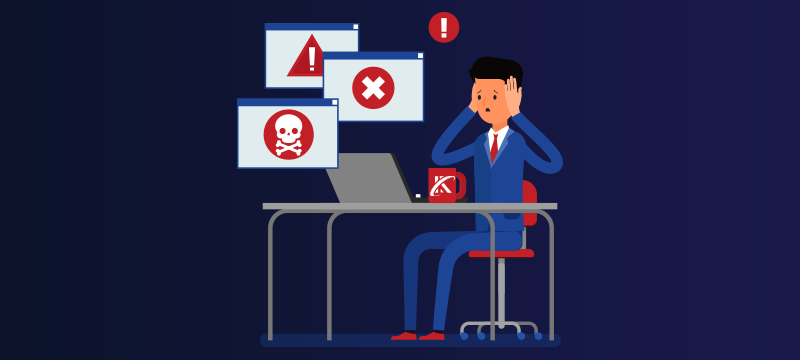With today’s organisations heavily reliant on technology, robust cybersecurity is vital. However, despite the availability of sophisticated security tools, one persistent vulnerability is human error. Even with best intentions and security protocols in place, human fallibility can often expose systems and sensitive data to significant risks. In this post, we will explore the various ways in which human error can jeopardise cybersecurity and discuss preventive measures to mitigate these risks.
- Weak passwords and authentication practices
One of the most common and easily avoidable mistakes made by users is the use of weak passwords. Easily guessable passwords, such as ‘123456’ or ‘password’, leave employees’ accounts susceptible to brute force attacks or password cracking techniques. At the same time, lax authentication practices, such as sharing passwords or leaving devices unlocked, create avenues for unauthorised access.To mitigate these risks, companies should enforce the use of complex and unique passwords and implement multifactor authentication (MFA) to add a further layer of security. This way, it makes it significantly harder for cybercriminals to gain unauthorised access.
- Phishing and social engineering attacks
Phishing attacks are widely used by cybercriminals to exploit human error. They involve the use of deceptive emails, messages or phone calls, tricking individuals into revealing sensitive information or clicking on malicious links. Such attacks often rely on exploiting human emotions, urgency or trust to manipulate users into taking actions that compromise security. In the future, we are also going to see AI used for phishing purposes, with cybercriminals using voice or even video cloning to trick employees.Education and awareness campaigns play a vital role in preventing phishing attacks. Businesses should regularly train employees and users to recognise common phishing techniques and encourage a cautious approach when interacting with unfamiliar or suspicious requests. Implementing robust email filters, making use of email certificates and deploying anti-malware tools can also help mitigate potential threats.
- Negligent handling of sensitive data
Human error can result in the careless handling of sensitive data, leading to unintended consequences. Leaving confidential documents unattended, failing to secure physical assets or sharing sensitive information via insecure channels are all examples of negligent behaviour that can compromise data security. Additionally, accidental data breaches caused by unintentional disclosure or misdirected emails can also have severe repercussions.To minimise these risks, businesses should establish clear data handling policies, emphasising the importance of data protection and confidentiality. Employees must be regularly trained on proper data handling procedures, including secure document disposal, encryption techniques and secure file transfer methods. Furthermore, implementing data loss prevention (DLP) technologies can help identify and prevent accidental data breaches.
- Insider threats
While external threats often dominate discussions on cybersecurity, insider threats pose a significant risk to organisations. These threats can be either intentional or unintentional. Intentional insider threats involve employees with malicious intent, seeking to steal sensitive data, disrupt operations or compromise systems. Unintentional insider threats, on the other hand, stem from employees’ lack of awareness or adherence to security protocols.Mitigating insider threats requires a multi-faceted approach. Companies should implement strong access controls, limiting access privileges to only those required for job responsibilities. Regular monitoring of user activities, including network traffic analysis and anomaly detection, can help identify suspicious behaviour. Additionally, fostering a culture of security awareness and encouraging employees to report any suspicious activities can act as a deterrent against both intentional and unintentional insider threats.
- Unpatched software and neglected updates
Failure to apply security patches and updates in a timely manner exposes systems to known vulnerabilities. Cybercriminals often exploit these vulnerabilities to gain unauthorised access, install malware or extract sensitive data. However, human error plays a significant role in the negligence of patching and updating software. Users may overlook update notifications, delay installations due to inconvenience, or simply be unaware of the criticality of these updates.To address this issue, businesses should prioritise a robust patch management system. Automated updates and patch deployments can ensure that systems are up to date with the latest security fixes.
- Misconfiguration and poor security practices
Misconfigurations in systems, networks or applications can inadvertently expose sensitive data to external threats. This can occur due to human error during the initial setup or subsequent changes made without considering security implications. Examples include leaving default configurations unchanged, granting unnecessary privileges or failing to implement secure network segmentation.To minimise misconfiguration risks, companies should follow security best practices and conduct regular security audits. Automated tools can help identify misconfigurations and provide recommendations for remediation. Additionally, proper documentation and change management processes can ensure that security measures are maintained during system updates or modifications.
- Lack of regular backups
Human error can lead to accidental data loss or corruption, such as accidental deletion, system crashes or hardware failures. Without proper backup solutions in place, companies risk losing valuable data and facing significant disruptions.Regular backups are crucial for data resilience and recovery. Businesses should implement automated backup solutions and establish backup schedules to ensure that critical data is regularly and securely backed up. Additionally, conducting periodic restoration tests can verify the integrity and effectiveness of backup procedures.
Conclusion
While technological advancements continue to bolster cybersecurity, human error remains an ever-present threat. Weak passwords, phishing attacks, negligent data handling, insider threats, unpatched software, misconfigurations and lack of backups are just some examples of how human error can put cybersecurity at risk. With this in mind, it is vital that businesses prioritise security awareness, education and training to equip individuals with the knowledge and skills needed to mitigate these risks.
Looking for a hosting provider that takes your security seriously? Visit our homepage.

